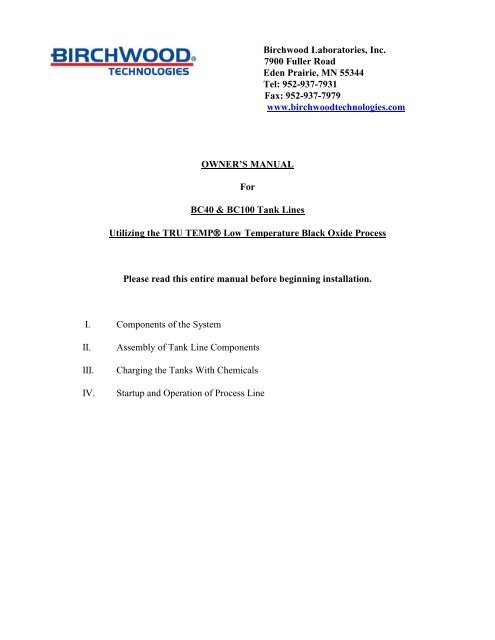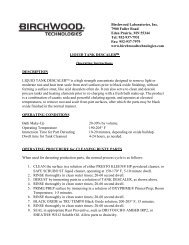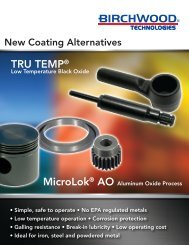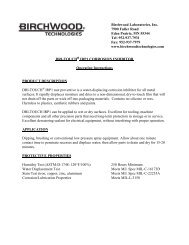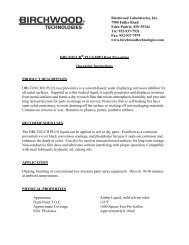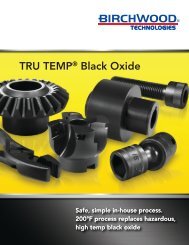Create successful ePaper yourself
Turn your PDF publications into a flip-book with our unique Google optimized e-Paper software.
<strong>Birchwood</strong> Laboratories, Inc.7900 Fuller RoadEden Prairie, MN 55344Tel: 952-937-7931Fax: 952-937-7979www.birchwoodtechnologies.comOWNER’S <strong>MANUAL</strong>ForBC40 & BC100 Tank LinesUtilizing the TRU TEMP® Low Temperature Black Oxide ProcessPlease read this entire manual before beginning installation.I. Components of the SystemII.III.IV.Assembly of Tank Line ComponentsCharging the Tanks With ChemicalsStartup and Operation of Process Line
I. COMPONENTS OF THE SYSTEM: BC40 Tank LineThe BC40 tank line utilizes a total of seven tanks, each measuring 16" X 24" X 24" deep (ID).Total capacity is 33 gallons when filled to a depth of 20", allowing for a 4" freeboard to the toprim. The tank line occupies about 3' x15' of floor space.Additional description follows:Tank 1 - Alkaline Clean Tank: Steel tank. Supplied with one 304 stainless steel immersionheater (4.5 kW) and controller with resettable overtemp breaker, controller mountingbracket and thermocouple bracket; ¾" bottom drain on rear wall with stainless ball valve.Operating temperature: 150° F.Tank 2 - Flowing Rinse Tank: Polypropylene tank. Fitted with ¾" water inlet and PVC ballvalve control mounted to the front for easy access, with 4” x 12” external overflowtrough, located on rear wall, with 1½" FPT outlet and hose barb connection, to beconnected to drain header.Tank 3 – Surface Conditioner Tank: Polypropylene tank. Fitted with 1” bottom drain on rearwall with PVC valve. Operating temperature: Room Temperature.Tank 4 - Flowing Rinse Tank: Polypropylene tank. Same as Tank 2 above, to be connected todrain header.Tank 5 - Blackening Tank: Steel tank, sheathed with 2” insulation. Supplied with two 304stainless steel immersion heaters (9 kW total) and controller with resettable overtempbreaker, controller mounting bracket & thermocouple bracket. Fitted with 1” bottom drainon rear wall with stainless steel valve. Operating temperature: 200-205° F.Tank 6 - Flowing Rinse Tank: Polypropylene tank. Same as Tank 2 above. To be connected toto drain header.Tank 7 - Sealant Tank: Steel tank. Fitted with 1" bottom drain on rear wall and stainless ballvalve. This tank is supplied with a welded steel drain board that attaches to the side wallof the tank to direct excess sealant back into the tank.Plumbing Connections: The BC40 tank line is supplied with water connections and utilizes ¾"nylon water line and compression fittings, along with all drain connections -- threadedhose barb fittings, flexible hose and clamps for connection to the drain header.
I. COMPONENTS OF THE SYSTEM: BC100 Tank LineThe BC100 tank line utilizes a total of seven tanks, each measuring 24" x 40" x 28½" deep (ID).Operating capacity is 100 gallons when filled to a depth of 24", allowing for a 4½" freeboard tothe top rim. The tank line occupies about 4' X 20' of floor space.Additional description follows:Tank 1 - Alkaline Clean Tank: Steel tank. Supplied with one 304 stainless steel immersionheater (9 kW) and controller with resettable overtemp breaker, controller mountingbracket and thermocouple bracket; Fitted with 1” bottom drain on rear wall with stainlessball valve. Operating temperature: 150° F.Tank 2 - Flowing Rinse Tank: Polypropylene tank. Fitted with ¾ " water inlet and PVC ballvalve control mounted to the front for easy access, with 4” x 12” external overflowtrough, located on rear wall, with 1½" FPT outlet and hose barb connection. To beconnected to drain header.Tank 3 - Activation Tank: Polypropylene tank. Fitted with 1” bottom drain on rear wall withPVC valve. Operating temperature: Room Temperature.Tank 4 - Flowing Rinse Tank: Polypropylene tank. Same as Tank 2 above. To be connected todrain header.Tank 5 - Blackening Tank: Steel tank, sheathed with 2” insulation. Supplied with two 304stainless immersion heaters (18 kW total) and controller with resettable overtempbreaker, mounting bracket and thermocouple bracket. Fitted with 1” bottom drain on rearwall with stainless steel valve. (Optional: Supplied with stainless steel FloKing verticalrecirculation pump (120 VAC). Operating temperature: 200-205° F.Tank 6 - Flowing Rinse Tank: Polypropylene tank. Same as Tank 2 above. To be connected todrain header.Tank 7 - Sealant Tank: Steel tank. Fitted with 1" bottom drain on rear wall and stainless ballvalve. This tank is supplied with a welded steel drain board that attaches to the side wallof the tank to direct excess sealant back into the tank.Plumbing Connections: The BC100 tank line is supplied with water connections and utilizes ¾"nylon water line and compression fittings, as well as all drain connections -- threadedhose barb fittings, flexible hose and clamps, for connection to the drain header.
II. ASSEMBLY OF TANK LINE COMPONENTSMATERIALS REQUIREDPressure-treated wood timbers: 6” X 6" X 52-80 lineal feet (see below).PVC pipe cement.Hand tools.ASSEMBLY GUIDELINESPlease find the appropriate tank line footprint for your installation:BC40 seven tank line: 25 inches (front-to-back) x 13 feet long.BC100 seven tank line: 41 inches (front-to-back) x 18 feet long.1. Select a location that can be served by water, drain and electrical utilities. If the line is to beset up against a wall, leave a minimum of 3 feet clearance between the tanks and the wall toallow for easy access to the utility hookups.2. Line up the wood timbers in three parallel rows running the length of the line, evenlyspaced.3. Set the tanks on the timbers, beginning at one end. Butt the tanks together, with the edgesof the top rims touching. Allow the front edge of the tanks to extend over the front timber by3" to provide toe space for the operator. Attach the drainboard to the steel oil tank.4. Assemble the water supply system. The flowing rinse tanks are designed to be fed withfresh water from a common supply line, with a main ball valve. The tanks interconnect bymeans of flexible nylon tubing and compression fittings. This configuration supplies freshwater, in series, from one tank to the next, etc. The tanks are designed so that fresh water canbe supplied from the front or rear. Choose the one which best fits your circumstances andplug the other inlet. The nylon tubing can be routed through the tank rim gussets to the nextrinse tank and secured using the plastic compression fittings provided. (Tighten fittings tofinger-tight + ¼ turn. DO NOT OVERTIGHTEN!)5. Assemble the drain system.The drain system can now be assembled, using flexible hose, clamps and PVC piping. Eachrinse tank overflow trough is supplied with a 90° threaded elbow with a hose barb. Assemblethese fittings, using Teflon tape, pointing the hose barbs downward. Clamp a length offlexible hose onto each hose barb. Trim these hoses so that each successive one is about ½"longer than the preceding one. This will result in a sloped drain header.
ASSEMBLY GUIDELINES (CONTINUED)Assemble the PVC drain header, using PVC pipe cement, locating the hose barb tees in theappropriate locations to accept the hoses from the rinse overflows. Finish the assembly byclamping the hoses onto the tees, making sure to maintain downward slope in the line.Connect the end of the drain line to the drain.6. The Immersion HeatersMount the immersion heaters at the rear of the heated tanks in a location that will notinterfere with the parts load. Bolt the heaters to the rim of the tank. Tank 1 (Cleaningtank) operates at 150° F and utilizes one immersion heater, powered by the controller.Tank 5 (black oxide tank) operates at 200° F and utilizes two immersion heaters, poweredby a single controller.Mount the control boxes either on the plastic brackets provided, (bolted to the rear wallrim) or on the wall, if preferred. Connect to an appropriate power supply panel.CAREFULLY route the copper thermocouple tubes through the brackets in the tank.Note: These thermocouples are made of copper capillary tubes – not wire. Handle withcare and do not kink them. They are covered by a protective Teflon sheath. Do notdamage or remove this covering.
III. CHARGING THE TANKS WITH CHEMICALSNote: Please consult with your BIRCHWOOD TECHNOLOGIES representative for guidance inchoosing and mixing the appropriate chemical products for your application.Now that the mechanical systems of the tank line are operational, the tanks can be filled withchemicals to prepare for actual processing. Each tank uses a different solution, as follows:Tank 1 - Cleaning TankIf you are using SAFE SCRUB® ST liquid cleaner, mix the product at 20% by volume:For a BC40 tank, put about 10 gallons of water into the tank, carefully add 7 gallons of SAFESCRUB ST liquid, then finish filling the tank with water to a level 4” from the top rim.For a BC100 tank, put about 20 gallons of water into the tank, carefully add 20 gallons of SAFESCRUB ST liquid, then finish filling the tank with water to a level 4 ½” from the top rim.Or, if you are using PRESTO KLEEN® HP powdered cleaner, mix the product at 8 oz. pergallon of water. The powder dissolves best when it is stirred into warm water, as follows:Fill the tank about 2/3 full with tap water. Start the heater and raise the temperature to about130°F. Carefully stir in the PRESTO KLEEN powder.For a BC40 tank, add 16 pounds of PRESTO KLEEN HP powder and stir well to dissolve.For a BC100 tank, add 50 pounds of PRESTO KLEEN powder and stir well to dissolve.When the powder is dissolved, finish filling the tank with water to a level 4” from the top rim.Tank 2 - Overflow Rinse TankOpen the water valve and fill the tank with water to the level of the overflow slots on the rearwall of the tank.Tank 3 - OXYPRIME® Primer/PrepTankWhen using OXYPRIME® POWDER, mix the product at 1 lb/gallon.For a BC40 tank, fill the tank about 2/3 with tap water. Carefully stir in 33 pounds ofOXYPRIME POWDER.For a BC100 tank, fill the tank about 2/3 with tap water. Carefully stir in 100 pounds ofOXYPRIME POWDER.When the powder is dissolved, finish filling the tank with water to a level 4” from the top rim.
Tank 4 - Overflow Rinse (see Tank 2)Tank 5 – TRU TEMP®XL Black OxideTankWhen using TRU TEMP XL, mix the product at 50% by volume.For a BC40 tank, put about 10 gallons of water into the tank. Carefully stir in 17 gallons of TRUTEMP XL concentrate. Then fill the tank with water to normal operating level. Stir well.For a BC100 tank, put about 20 gallons of water into the tank. Carefully stir in 50 gallons ofTRU TEMP XL concentrate. Then fill the tank with water to normal operating level. Stir well.Tank 6 - Overflow Rinse (see Tank 2)Tank 7 - Sealant TankFill the tank with appropriate sealant product to normal operating level - 4” below the top rim.Please see the operating instructions for the individual sealant product for mixing details.The tank line is now fully charged and ready for operation. If other chemical products are beingused in the line, please consult with your BIRCHWOOD TECHNOLOGIES representative forcharging and operating instructions.Please note: When turning the immersion heaters on, please remember that the dials on thecontrollers are rheostats. As such, the power is either on or off. When ready to heat up the tank,turn the dial to the desired operating temperature - no higher. Dialing in a higher temperaturewill not heat the tanks any faster - it will result in a higher temperature which may be too high forproper operation of the chemical solution, or localized heating, which may damage the chemicalproduct in the tank.
IV. STARTUP AND OPERATION OF PROCESS LINEThe tank line is now fully charged and ready for operation. Though there are process cycleparameters that can be used, here are a few guidelines:Start all heaters. Adjust heater rheostats to raise the temperature to the proper operating levels.Once the tanks reach normal operating temperatures, stir the bath well to equalize thetemperature throughout the tank. This is important for good operation of the product.Open water valves and adjust, if necessary, to obtain correct flow rates. Since the three rinsetanks are fed with water in series, you may need to throttle back on the first one in line in order toequalize the flow to the other two tanks. Adjust water flow to achieve 1-3 gpm in each rinse.Parts can be processed on racks, in baskets or in rotating barrels. Each load should be designedto minimize or eliminate flat against flat contact or poor drainage problems etc. High value ordelicate parts should be hung individually on hooks. Other small parts can be processed in bulk.Your BIRCHWOOD TECHNOLOGIES representative can assist in determining the best partshandling techniques.In most cases, the parts are free of noticeable rust and are coated with a machining or stampingfluid. The basic TRU TEMP black oxide process utilizes the following steps:1. Clean the parts to remove oils, dirt and other surface soils by soaking in the cleaningsolution at 150° F for 5-8 minutes. Most parts clean up very well in this way; however,parts that carry heavy oils, grease, drawing lubricants, etc., are more difficult to clean andmay require longer times or some agitation of the solution in order to make the cleaningmore aggressive.2. Rinse in cold, overflowing tap water tank; 20 seconds.3. Prime & Prep the surface for blackening by immersing parts in OXYPRIME Primer/PrepSolution at Room Temperature for 5-8 minutes4. Rinse in cold, overflowing tap water tank; 20 seconds.5. Blacken the parts by immersing them in the TRU TEMP solution at 200-205° F for 10-12minutes.6. Rinse in cold, overflowing tap water tank; 20 seconds.7. Seal the finish and displace water by immersion in BIRCHWOOD TECHNOLOGIESsealant of your choice. Allow parts to drain or dry.
The processing steps are explained in more detail below:Tank 1 - Cleaning Tank: 150°F; 5-8 minute immersion.The function of this step is to remove oil and surface soils from the parts by emulsifying themand suspending them in the solution. The heat and alkaline chemicals do most of the work,although agitation is generally helpful.The best temperature here is 150°F. Lower temperatures slow down the cleaning action, but maybe suitable for easily removed soils such as water soluble oils or synthetic machining fluids.Higher temperatures may be necessary for difficult soils such as drawing lubricants. In thesecases, 160-180°F, or higher concentrations, may be needed. Your BIRCHWOODTECHNOLOGIES representative can guide you in this area.Avoid overheating the solution, as this can lead to flash drying of the parts before they can be rinsed.Once the cleaning solution has hot dried on the parts, it is generally difficult to rinse off in a coldrinse tank. So, use the lowest temperature that will do the job.The PRESTO KLEEN HP or SAFE SCRUB ST solutions are both heavy duty cleaners with high oilholdingcapacity, designed for use with the TRU TEMP process. They remove the oil from the partsby emulsifying it and suspending it in the solution.When the cleaning solution begins to be saturated with oil, an oil-slick may form on the liquidsurface. This oil slick should be skimmed off the surface to avoid the possibility of re-depositing iton the cleaned parts.Tank 2 - Overflowing Rinse Tank: Room Temperature; 20 second immersion.The objective here is to remove all cleaner residues from the parts before proceeding to the nexttank. This rinse tank can also serve as a checkpoint, or an indicator of part cleanliness. If the part iscompletely clean and free of oil, the water will sheet off uniformly when the part is removed fromthe tank. Any water beading up on the surface normally indicates the presence of oil and the need formore cleaning, in the form of longer cleaning times, higher temperatures or cleaner solutionmaintenance. Keeping an eye on the sheeting action of the rinse water is a good way to monitor theeffectiveness of the cleaning solution in tank 1.Tank 3 - OXYPRIME Primer/Conditioner: 5-8 minute immersion.This tank operates at a mildly acidic pH to serve two functions: it neutralizes any alkalinecleaner residues on the parts, but its main function is to pre-activate the surface of the iron orsteel part by coating it with iron oxalate. This makes the steel more receptive to the blackeningreaction to follow. Normally, the steel parts will darken slightly during this operation. Or, theymay take on a frosty, gray appearance. No etching takes place here.
A general rule is: More reactive alloys, such as low Carbon steels, cast irons and powder metalsreactive quickly and require only 2-4 minutes immersion in this tank. Middle of the road alloys,such as heat-treatable grades, medium Carbon steels are somewhat less reactive and will require5-8 minutes immersion. Low reactive alloys, such as O1, A2, D2, M2 may require 10-15 minuteimmersions in this tank to make them reactive enough to blacken well.Here, again, your BIRCHWOOD TECHNOLOGIES representative can offer guidance.Tank 4 - Overflowing Rinse Tank: room temperature; 20 seconds.This rinse removes OXYPRIME residues before the parts enter the blackening tank. Keeping itclean helps ensure that the chemical balance of the blackening solution is maintained at properlevels.Tank 5 – TRU TEMP Black Oxide Tank: 200-205°F, 10-12 minutes.The parts are now free of oil and chemically prepared for blackening. They are ready forTRU TEMP black oxide, which converts the metal surface to black magnetite.The TRU TEMP black oxide bath can be operated as a semi-permanent bath in the line, requiringonly periodic replenishment with fresh concentrate. BIRCHWOOD TECHNOLOGIES suppliestest kits which allow the user to determine the strength of the bath and make proper additions.Tank 6 - Overflow Rinse Tank: room temperature; 20 second immersion.This rinse step is somewhat less critical than the others in the line. However, blackening residuesmust be rinsed off prior to the sealing steps.Tank 7 - Sealant Tank: room temperature; 1 minute immersion.Because the black coating has a porous crystal structure, it acts as an excellent absorbent base fora protective oil, wax or other suitable top coating. In fact, the coating lets the steel hold more oilthan it normally would and results in a dramatic increase in corrosion resistance.The type of sealant used is determined by the end use of the part. It is possible to produce avariety of finish properties by choosing the appropriate sealant.


